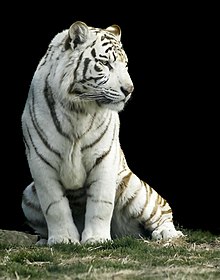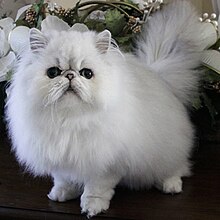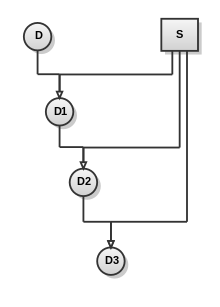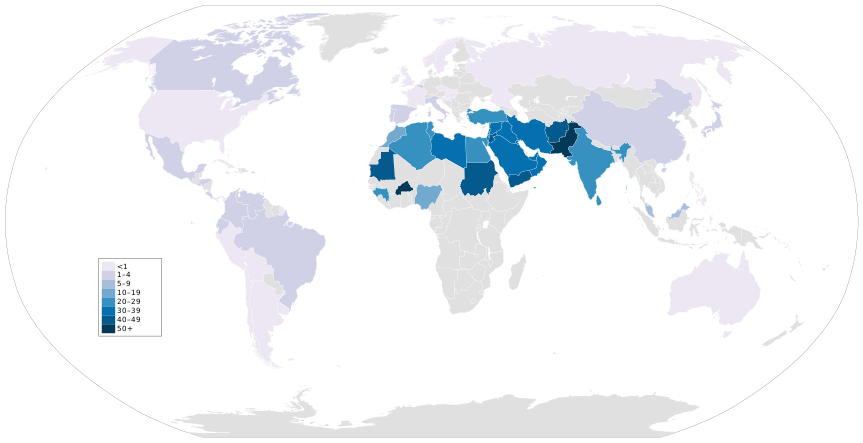Inbreeding
Inbreeding is the production of offspring from the mating or breeding of individuals or organisms that are closely related genetically.[2] By analogy, the term is used in human reproduction, but more commonly refers to the genetic disorders and other consequences that may arise from expression of deleterious recessive traits resulting from incestuous sexual relationships and consanguinity. Animals avoid incest only rarely.[3]
Inbreeding results in
Inbreeding is a technique used in
Inbreeding can significantly influence gene expression which can prevent inbreeding depression.[14]
Overview
Offspring of biologically related persons are subject to the possible effects of inbreeding, such as
Malformations or harmful traits can stay within a population due to a high homozygosity rate, and this will cause a population to become fixed for certain traits, like having too many bones in an area, like the vertebral column of wolves on
There may also be other deleterious effects besides those caused by recessive diseases. Thus, similar immune systems may be more vulnerable to infectious diseases (see Major histocompatibility complex and sexual selection).[20]
Inbreeding history of the population should also be considered when discussing the variation in the severity of inbreeding depression between and within species. With persistent inbreeding, there is evidence that shows that inbreeding depression becomes less severe. This is associated with the unmasking and elimination of severely deleterious recessive alleles. However, inbreeding depression is not a temporary phenomenon because this elimination of deleterious recessive alleles will never be complete. Eliminating slightly deleterious mutations through inbreeding under moderate selection is not as effective. Fixation of alleles most likely occurs through Muller's ratchet, when an asexual population's genome accumulates deleterious mutations that are irreversible.[21]
Despite all its disadvantages, inbreeding can also have a variety of advantages, such as ensuring a child produced from the mating contains, and will pass on, a higher percentage of its mother/father's genetics, reducing the recombination load,[22] and allowing the expression of recessive advantageous phenotypes. Some species with a Haplodiploidy mating system depend on the ability to produce sons to mate with as a means of ensuring a mate can be found if no other male is available. It has been proposed that under circumstances when the advantages of inbreeding outweigh the disadvantages, preferential breeding within small groups could be promoted, potentially leading to speciation.[23]
Genetic disorders
Children of parent-child or sibling-sibling unions are at an increased risk compared to cousin-cousin unions.[26]: 3 Inbreeding may result in a greater than expected phenotypic expression of deleterious recessive alleles within a population.[27] As a result, first-generation inbred individuals are more likely to show physical and health defects,[28][29] including:
- Lower intelligence quotient levels and higher incidence rates of being affected by an intellectual disability
- Reduced fertility both in litter size and sperm viability
- Increased genetic disorders
- Fluctuating facial asymmetry
- Lower birth rate
- Higher infant mortality and child mortality[30]
- Smaller adult size
- Loss of immune system function
- Increased cardiovascular risks[31]
The isolation of a small population for a period of time can lead to inbreeding within that population, resulting in increased genetic relatedness between breeding individuals. Inbreeding depression can also occur in a large population if individuals tend to mate with their relatives, instead of mating randomly.
Due to higher
Island species are often very inbred, as their isolation from the larger group on a mainland allows natural selection to work on their population. This type of isolation may result in the formation of race or even speciation, as the inbreeding first removes many deleterious genes, and permits the expression of genes that allow a population to adapt to an ecosystem. As the adaptation becomes more pronounced, the new species or race radiates from its entrance into the new space, or dies out if it cannot adapt and, most importantly, reproduce.[34]
The reduced genetic diversity, for example due to a bottleneck will unavoidably increase inbreeding for the entire population. This may mean that a species may not be able to adapt to changes in environmental conditions. Each individual will have similar immune systems, as immune systems are genetically based. When a species becomes endangered, the population may fall below a minimum whereby the forced interbreeding between the remaining animals will result in extinction.
Natural breedings include inbreeding by necessity, and most animals only migrate when necessary. In many cases, the closest available mate is a mother, sister, grandmother, father, brother, or grandfather. In all cases, the environment presents stresses to remove from the population those individuals who cannot survive because of illness.[citation needed]
There was an assumption[by whom?] that wild populations do not inbreed; this is not what is observed in some cases in the wild. However, in species such as horses, animals in wild or feral conditions often drive off the young of both sexes, thought to be a mechanism by which the species instinctively avoids some of the genetic consequences of inbreeding.[35] In general, many mammal species, including humanity's closest primate relatives, avoid close inbreeding possibly due to the deleterious effects.[26]: 6
Examples
Although there are several examples of inbred populations of wild animals, the negative consequences of this inbreeding are poorly documented.[citation needed] In the South American sea lion, there was concern that recent population crashes would reduce genetic diversity. Historical analysis indicated that a population expansion from just two matrilineal lines was responsible for most of the individuals within the population. Even so, the diversity within the lines allowed great variation in the gene pool that may help to protect the South American sea lion from extinction.[36]

In lions,
In Central California,
Cheetahs are another example of inbreeding. Thousands of years ago, the cheetah went through a population bottleneck that reduced its population dramatically so the animals that are alive today are all related to one another. A consequence from inbreeding for this species has been high juvenile mortality, low fecundity, and poor breeding success.[41]
In a study on an island population of song sparrows, individuals that were inbred showed significantly lower survival rates than outbred individuals during a severe winter weather related population crash. These studies show that inbreeding depression and ecological factors have an influence on survival.[21]
The Florida panther population was reduced to about 30 animals, so inbreeding became a problem. Several females were imported from Texas and now the population is better off genetically.[42][43]
Measures
A measure of inbreeding of an individual A is the probability F(A) that both alleles in one locus are derived from the same allele in an ancestor. These two identical alleles that are both derived from a common ancestor are said to be
Another useful measure that describes the extent to which two individuals are related (say individuals A and B) is their coancestry coefficient f(A,B), which gives the probability that one randomly selected allele from A and another randomly selected allele from B are identical by descent.[45] This is also denoted as the kinship coefficient between A and B.[46]
A particular case is the self-coancestry of individual A with itself, f(A,A), which is the probability that taking one random allele from A and then, independently and with replacement, another random allele also from A, both are identical by descent. Since they can be identical by descent by sampling the same allele or by sampling both alleles that happen to be identical by descent, we have f(A,A) = 1/2 + F(A)/2.[47]
Both the inbreeding and the coancestry coefficients can be defined for specific individuals or as average population values. They can be computed from genealogies or estimated from the population size and its breeding properties, but all methods assume no selection and are limited to neutral alleles.
There are several methods to compute this percentage. The two main ways are the path method[48][44] and the tabular method.[49][50]
Typical coancestries between relatives are as follows:
- Father/daughter or mother/son → 25% (1⁄4)
- Brother/sister → 25% (1⁄4)
- Grandfather/granddaughter or grandmother/grandson → 12.5% (1⁄8)
- Half-brother/half-sister, Double cousins → 12.5% (1⁄8)
- Uncle/niece or aunt/nephew → 12.5% (1⁄8)
- Great-grandfather/great-granddaughter or great-grandmother/great-grandson → 6.25% (1⁄16)
- Half-uncle/niece or half-aunt/nephew → 6.25% (1⁄16)
- First cousins → 6.25% (1⁄16)
Animals
Wild animals

- Banded mongoose females regularly mate with their fathers and brothers.[51]
- Bed bugs: North Carolina State University found that bedbugs, in contrast to most other insects, tolerate incest and are able to genetically withstand the effects of inbreeding quite well.[52]
- Common fruit fly females prefer to mate with their own brothers over unrelated males.[1]
- Cottony cushion scales: 'It turns out that females in these hermaphrodite insects are not really fertilizing their eggs themselves, but instead are having this done by a parasitic tissue that infects them at birth,' says Laura Ross of Oxford University's Department of Zoology. 'It seems that this infectious tissue derives from left-over sperm from their father, who has found a sneaky way of having more children by mating with his daughters.'[53][54]
- eat them alive from the inside.[55]

Domestic animals


Breeding in domestic animals is primarily assortative breeding (see selective breeding). Without the sorting of individuals by trait, a breed could not be established, nor could poor genetic material be removed.
Breeders must avoid breeding from individuals that demonstrate either homozygosity or heterozygosity for disease causing alleles.[60] The goal of preventing the transfer of deleterious alleles may be achieved by reproductive isolation, sterilization, or, in the extreme case, culling. Culling is not strictly necessary if genetics are the only issue in hand. Small animals such as cats and dogs may be sterilized, but in the case of large agricultural animals, such as cattle, culling is usually the only economic option.
The issue of casual breeders who inbreed irresponsibly is discussed in the following quotation on cattle:
Meanwhile, milk production per cow per lactation increased from 17,444 lbs to 25,013 lbs from 1978 to 1998 for the Holstein breed. Mean breeding values for milk of Holstein cows increased by 4,829 lbs during this period.[61] High producing cows are increasingly difficult to breed and are subject to higher health costs than cows of lower genetic merit for production (Cassell, 2001).
Intensive selection for higher yield has increased relationships among animals within breed and increased the rate of casual inbreeding.
Many of the traits that affect profitability in crosses of modern dairy breeds have not been studied in designed experiments. Indeed, all crossbreeding research involving North American breeds and strains is very dated (McAllister, 2001) if it exists at all.[62]
The BBC produced two documentaries on dog inbreeding titled Pedigree Dogs Exposed and Pedigree Dogs Exposed: Three Years On that document the negative health consequences of excessive inbreeding.
Linebreeding
Linebreeding is a form of inbreeding. There is no clear distinction between the two terms, but linebreeding may encompass crosses between individuals and their descendants or two cousins.[58][63] This method can be used to increase a particular animal's contribution to the population.[58] While linebreeding is less likely to cause problems in the first generation than does inbreeding, over time, linebreeding can reduce the genetic diversity of a population and cause problems related to a too-small gene pool that may include an increased prevalence of genetic disorders and inbreeding depression.[citation needed]
Outcrossing
Outcrossing is where two unrelated individuals are crossed to produce progeny. In outcrossing, unless there is verifiable genetic information, one may find that all individuals are distantly related to an ancient progenitor. If the trait carries throughout a population, all individuals can have this trait. This is called the founder effect. In the well established breeds, that are commonly bred, a large gene pool is present. For example, in 2004, over 18,000 Persian cats were registered.[64] A possibility exists for a complete outcross, if no barriers exist between the individuals to breed. However, it is not always the case, and a form of distant linebreeding occurs. Again it is up to the assortative breeder to know what sort of traits, both positive and negative, exist within the diversity of one breeding. This diversity of genetic expression, within even close relatives, increases the variability and diversity of viable stock.
Laboratory animals
Systematic inbreeding and maintenance of inbred strains of
Humans

Effects
Inbreeding increases homozygosity, which can increase the chances of the expression of deleterious or beneficial recessive alleles and therefore has the potential to either decrease or increase the fitness of the offspring. Depending on the rate of inbreeding, natural selection may still be able to eliminate deleterious alleles. [67]With continuous inbreeding, genetic variation is lost and homozygosity is increased, enabling the expression of recessive deleterious alleles in homozygotes. The coefficient of inbreeding, or the degree of inbreeding in an individual, is an estimate of the percent of homozygous alleles in the overall genome.[68] The more biologically related the parents are, the greater the coefficient of inbreeding, since their genomes have many similarities already. This overall homozygosity becomes an issue when there are deleterious recessive alleles in the gene pool of the family.[69] By pairing chromosomes of similar genomes, the chance for these recessive alleles to pair and become homozygous greatly increases, leading to offspring with autosomal recessive disorders.[69] However, these deleterious effects are common for very close relatives but not for those related on the 3rd cousin or greater level, who exhibit increased fitness.[3]
Inbreeding is especially problematic in small populations where the genetic variation is already limited.[70] By inbreeding, individuals are further decreasing genetic variation by increasing homozygosity in the genomes of their offspring.[71] Thus, the likelihood of deleterious recessive alleles to pair is significantly higher in a small inbreeding population than in a larger inbreeding population.[70]
The fitness consequences of consanguineous mating have been studied since their scientific recognition by Charles Darwin in 1839.[72][73] Some of the most harmful effects known from such breeding includes its effects on the mortality rate as well as on the general health of the offspring.[74] Since the 1960s, there have been many studies to support such debilitating effects on the human organism.[71][72][74][75][76] Specifically, inbreeding has been found to decrease fertility as a direct result of increasing homozygosity of deleterious recessive alleles.[76][77] Fetuses produced by inbreeding also face a greater risk of spontaneous abortions due to inherent complications in development.[78] Among mothers who experience stillbirths and early infant deaths, those that are inbreeding have a significantly higher chance of reaching repeated results with future offspring.[79] Additionally, consanguineous parents possess a high risk of premature birth and producing underweight and undersized infants.[80] Viable inbred offspring are also likely to be inflicted with physical deformities and genetically inherited diseases.[68] Studies have confirmed an increase in several genetic disorders due to inbreeding such as blindness, hearing loss, neonatal diabetes, limb malformations, disorders of sex development, schizophrenia and several others.[68][81] Moreover, there is an increased risk for congenital heart disease depending on the inbreeding coefficient (See coefficient of inbreeding) of the offspring, with significant risk accompanied by an F =.125 or higher.[28]
Prevalence
The general negative outlook and eschewal of inbreeding that is prevalent in the Western world today has roots from over 2000 years ago. Specifically, written documents such as the Bible illustrate that there have been laws and social customs that have called for the abstention from inbreeding. Along with cultural taboos, parental education and awareness of inbreeding consequences have played large roles in minimizing inbreeding frequencies in areas like Europe. That being so, there are less urbanized and less populated regions across the world that have shown continuity in the practice of inbreeding.
The continuity of inbreeding is often either by choice or unavoidably due to the limitations of the geographical area. When by choice, the rate of consanguinity is highly dependent on religion and culture.
Of the practicing regions, Middle Eastern and northern Africa territories show the greatest frequencies of consanguinity.[70]
Among these populations with high levels of inbreeding, researchers have found several disorders prevalent among inbred offspring. In
Royalty and nobility
Inter-nobility
In
See also
- Álvarez incest case
- Coefficient of relationship
- Consanguinity
- Cousin marriage
- Cousin marriage in the Middle East
- Evolution of sexual reproduction
- Exogamy
- Founder effect
- F-statistics
- Fritzl case
- Genetic diversity
- Genetic purging
- Genetic sexual attraction
- Heterozygote advantage
- Identical ancestors point
- Inbreeding depression
- Inbreeding in fish
- Incest
- Incest taboo
- Insular dwarfism
- Intellectual inbreeding
- Legality of incest
- List of coupled cousins
- Mahram
- Outbreeding depression
- Outcrossing
- Proximity of blood
- Prohibited degree of kinship
- Selective breeding
- Self-incompatibility in plants(how some plants avoid inbreeding)
References
- ^ PMID 23251487.
- ^ Inbreeding at the Encyclopædia Britannica
- ^ S2CID 233718913.
- S2CID 44576506.
- PMID 7939661.
- .
- ^ PMID 3898363.
- ^ ISBN 0-201-40754-X
- S2CID 881556.[page needed]
- PMID 12807795.
- PMID 25407077.
- S2CID 198156378.
- S2CID 24302475.
- PMID 22714404.
- S2CID 84009643.
- ISBN 978-0-226-79854-7.
- ^ Shields, W. M. 1982. Philopatry, Inbreeding, and the Evolution of Sex. Print. 50–69.
- PMID 10716731.
- S2CID 198156086.
- PMID 12737660.
- ^ PMID 21237809.
- ISBN 978-0-87395-618-5.
- PMID 22152499.
- ISBN 0-7637-1511-5.
- PMID 2497870.
- ^ ISBN 978-0-8047-5141-4.
- ISBN 978-0-7167-3771-1.
- ^ PMID 19805052.
- S2CID 6086127.
- PMID 27632780.
- PMID 27084548.
- PMID 8359962.
- S2CID 4375158.
- JSTOR 4512538.
- ^ "ADVS 3910 Wild Horses Behavior", College of Agriculture, Utah State University.
- ^ Freilich S, Hoelzel AR, Choudhury SR. "Genetic diversity and population genetic structure in the South American sea lion (Otaria flavescens)" (PDF). Department of Anthropology and School of Biological & Biomedical Sciences, University of Durham, U.K.
- ^ PMID 1940281.
- S2CID 27867275.
- .
- S2CID 86833574.
- .
- ^ UCF report on complex genetic health of Florida panther
- ^ Johnson, Warren E., David P. Onorato, Melody E. Roelke, E. Darrell Land, Mark Cunningham, Robert C. Belden, Roy McBride et al. "Genetic restoration of the Florida panther." Science 329, no. 5999 (2010): 1641-1645.
- ^ S2CID 83865141.
- PMID 17246175.
- hdl:10261/121301.
- ^ Malecot G. Les Mathématiques de l'hérédité. Paris: Masson et Cie. p. 1048.
- ^ How to compute and inbreeding coefficient (the path method), Braque du Bourbonnais.
- ^ Christensen K. "4.5 Calculation of inbreeding and relationship, the tabular method". Genetic calculation applets and other programs. Genetics pages. Archived from the original on 2010-03-27. Retrieved 2010-10-07.
- S2CID 2636127.
- ^ PMID 25540153.
- ^ "Insect Incest Produces Healthy Offspring". 8 December 2011.
- S2CID 15361433.
- ^ "The Evolution of Hermaphroditism by an Infectious Male-Derived Cell Lineage" (PDF). pure.rug.nl. April 26, 2019. Archived (PDF) from the original on April 22, 2023.
- ISBN 978-0-13-227584-2.
- ^ "Polycystic kidney disease | International Cat Care". icatcare.org. Retrieved 2016-07-08.
- ^ "Polycystic Kidney Disease". www.vet.cornell.edu. Retrieved 2016-07-08.
- ^ ISBN 978-92-5-104340-0.
- PMID 30622631.
- ^ G2036 Culling the Commercial Cow Herd: BIF Fact Sheet, MU Extension Archived 2016-04-16 at the Wayback Machine. Extension.missouri.edu. Retrieved on 2013-03-05.
- ^ "Genetic Evaluation Results". Archived from the original on August 27, 2001.
- ^ S1008: Genetic Selection and Crossbreeding to Enhance Reproduction and Survival of Dairy Cattle (S-284) Archived 2006-09-10 at the Wayback Machine. Nimss.umd.edu. Retrieved on 2013-03-05.
- ^ Vogt D, Swartz HA, Massey J (October 1993). "Inbreeding: Its Meaning, Uses and Effects on Farm Animals". MU Extension. University of Missouri. Archived from the original on March 8, 2012. Retrieved April 30, 2011.
- ^ Top Cat Breeds for 2004. Petplace.com. Retrieved on 2013-03-05.
- PMID 22109912.
- ISSN 1572-9737.
- ^ .
- ^ PMID 7384341.
- ^ PMID 19811666.
- ^ PMID 6053617.
- ^ S2CID 146133244.
- ISBN 978-3-540-37654-5.
- ^ PMID 9915962.
- PMID 279005.
- ^ S2CID 31317976.
- PMID 1729895.
- S2CID 4338257.
- PMID 10191794.
- PMID 2603950.
- PMID 24294299.
- ^ Karsten-Gerhard Albertsen: The History & Life of the Reidenbach Mennonites (Thirty Fivers). Morgantown, Pennsylvania 1996, page 443.
- PMID 25060281.
- ISBN 978-0-9771961-7-3.
- ^ Seawright C. "Women in Ancient Egypt, Women and Law". thekeep.org. Archived from the original on 2010-12-27. Retrieved 2010-12-29.
- ^ King Tut Mysteries Solved: Was Disabled, Malarial, and Inbred
- ^ Bevan ER. "The House of Ptolomey". uchicago.edu.
